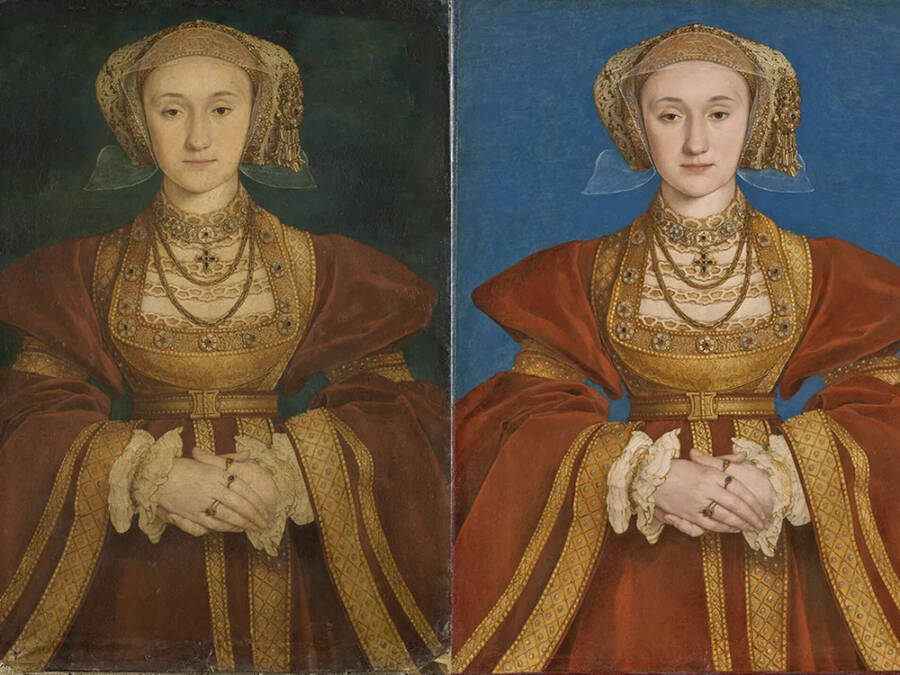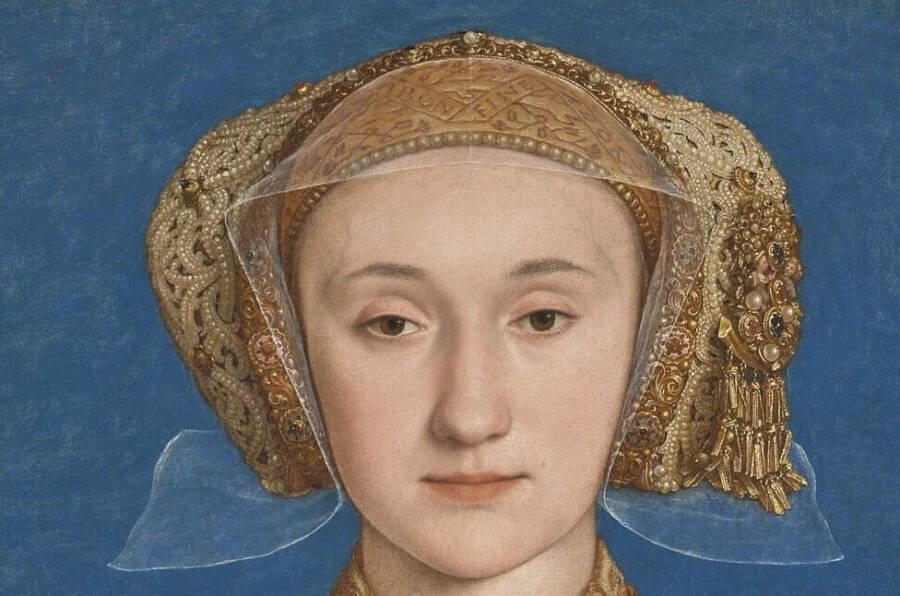Upon seeing Anne of Cleves' Portrait in 1539, King Henry VIII of England reportedly became enchanted. Now, the recent restoration shows what that portrait looked like when the king first laid his eyes on it nearly 500 years ago.

Adrien Didierjean/Louvre MuseumHans Holbein’s 1539 portrait of Anne of Cleves (left) next to its restoration (right).
The Louvre Museum in Paris has just announced a successful restoration of Hans Holbein’s portrait of Anne of Cleves — the painting rumored to have persuaded King Henry VIII of England to marry the young woman.
Using techniques to erase centuries of grime and revitalize the portrait’s vibrant colors, the restoration team has successfully unveiled the state of the portrait as Henry VIII would have seen it nearly 500 years ago.
Who Was Anne Of Cleves
Anne of Cleves was born in 1515 in Germany to a wealthy family. She grew up expecting to be wed for political purposes, and in 1539, King Henry VIII of England began negotiating her hand in marriage.
That year, Henry sent the painter Hans Holbein to capture the young woman’s likeness so he could see what his future bride looked like. The portrait, which shows Anne of Cleves adorned in an ornate red and gold dress, caught the king’s attention immediately.
According to historian Tracy Borman in Elizabeth’s Women: Friends, Rivals and Foes Who Shaped the Virgin Queen, Henry took delight in “the pretty, doll-like face that looked back at him, with its fair hair, delicate eyes, mouth, and chin, and demure, maidenly expression.”
However, this fascination with Anne of Cleves’ likeness did not last. Upon seeing her in person for the first time in 1540, King Henry VIII declared that she was not nearly as beautiful as the portrait made her out to be.
“I like her not! I like her not!” he reportedly said.
Despite his disappointment, the king wed Anne of Cleves on Jan. 6, 1540 to avoid political conflict with her family and other Protestants. She became his fourth wife of six.
And so the legend of Anne of Cleves’ enchanting portrait took root in history. Now, it has been restored so that contemporary viewers may see it as King Henry VIII once did.
Restoring The Famed Portrait
The Louvre has owned the Anne of Cleves portrait since the museum first opened in 1793. However, this is the first time art restorers have attempted such a thorough conservation. Previously, the portrait portrayed a doll-like Anne of Cleves in front of a muted green background. The details of her dress were apparent, but they lacked luster, and the colors were dull and faded.
The recent restoration unveils a masterful work of color and detail that pays credence to its rumored enchanting powers.
Instead of standing in front of a moody, dark background, the figure of Anne of Cleves is accentuated by bright blue, contrasting with the vibrant red and gold of her gown and headdress.
The various gold pieces adorning her body appear to shine, and the precise hazel color of her eyes is finally discernible. The hint of a small beauty mark can be seen above her mouth.
On her headdress reads the words “Bon Fine,” a common expression in 16th century Germany meaning “to a happy end,” according to Tudor historian Natalie Grueninge. This motto may have served to wish the portrait’s subject good fortune in her future marriage to Henry VIII.

Adrien Didierjean/Louvre MuseumA closeup of Anne of Cleves’ headdress.
“It just shows that Holbein really was amongst the leading portrait painters of his era,” art historian Adam Busiakiewicz wrote in the blog Art History News. “The face, coloring, and details are just otherworldly.”
Busiakiewicz also celebrated the museum’s bold attempt at restoration, suggesting that the Louvre has historically veered on the side of caution and non-interference.
“For an institution that is usually rather cautious with restoring their masterpieces, perhaps the tides are finally turning?” Busiakiewicz wrote.
After reading about this legendary Anne of Cleves portrait, learn about Henry VIII’s second wife Anne Boleyn, the first English queen to be executed. Then, meet Catherine Howard, Henry’s other beheaded wife.





